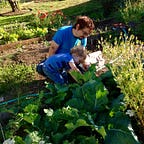The Gifts of King Plantago
Wild Foods Challenge, Day 20
For the month of June, I’ll be taking the Wild Foods Challenge and trying to incorporate more found and foraged edible ingredients in my diet. I hope you’ll follow along!
And you, Plantain, mother of herbs,
Open from the east, mighty inside.
over you chariots creaked, over you queens rode,
over you brides cried out, over you bulls snorted.
You withstood all of them, you dashed against them.
May you likewise withstand poison and infection….— Anglo-Saxon 9 Herb Charm
I remember first encountering plantain (Plantago spp.) in a Florida outfield, where I’d been exiled due to a lackluster interest in little league baseball. Its flowers extended six inches or so above the ground, waving in the breeze like tentacled creatures from some ethereal place.
Little did I know at the time that this humble and ubiquitous plant had so many uses, and would prove to be one of the tastier wild greens!
Native to Europe, where the Saxons considered it one of the “Nine Sacred Herbs,” there is a dark side to plantain as a signifier of imperialism. Essentially, plantain is spready. Its seeds are mucilaginous (more on that in a minute), which allows them to cling and survive. One of the first naturalized European stowaways, it soon became so abundant in North America that some indigenous communities refer to it as “white-man’s footprint.”
The two most abundant species you’ll find in your neighborhood are Plantago lanceolata (lance-leafed, narrow, ribwort, or English plantain) and Plantago major (broadleaf, or common plantain). It’s easy to tell the two apart, and they’re often found growing right next to one another.
Plantain has been recognized since at least the time of that Anglo-Saxon charm above as an excellent general medicinal, especially for external scrapes and bruises. The entire plant can be used as a poultice or in a salve. Taken internally, the seeds (aka “psyllium seeds”) are especially useful for adding “bulk” to help digestion. They can be added to meals directly, or powdered and added to baked goods, or even stirred into smoothies.
AS A MATTER OF FACT, you can buy mixture of sugar, “orange flavoring,” and powdered plantain seeds for $15 at your local grocer’s: everybody’s favorite “Daily Fiber Therapy,” Metamucil. Next time, just make your own. The seeds of broad-leaf plantain dry on the stalks; strip, grind into powder, and use.
In my experience, the broad-leaf plantain is the nicest for eating. If you collect the leaves when young, you can add them directly to salads and stir-fries (see “potherbs”). The older leaves require the removal of the ribs (or a willingness to deal with a little stringiness). They are especially delicious, however, when made into chips, and here’s my favorite way to do it.
Plantain Cheese Chips
Ingredients:
- 10 or so enormous broad-leaf plantain leaves
- Cooking oil (olive is nice)
- Your favorite cheese, shredded, approx. 1 cup
- Finishing salt to taste
Instructions:
- Pre-heat oven to 375F.
- Clean your plantain leaves. For all wild greens (especially those found in the dreaded DOG PEE ZONE), I recommend submerging in a mixture of water and a few splashes of white vinegar for at least 10 minutes, swishing around occasionally.
3. Dry the leaves thoroughly. Use a paper towel.
4. (Optional.) De-rib the leaves. It seems like it would be tricky, but there’s a method. Pinch the base of the leaf, where the stalk meets the leaf itself. Gently wiggle until the very base of the leaf snaps all the way around. Grasping the leaf in one hand, slowly pull the stem away from the leaf. The majority of the ribs should pull out of the leaf.
5. On a cookie sheet, lay out leaves so that none are touching (you may want to do multiple batches). Brush each leaf in oil. Flip, then brush the other side.
6. Place in the oven for six minutes. The leaves should already be mostly crispy:
7. Flip and sprinkle each leaf with about a tablespoon of cheese. Place back in oven for three minutes.
8. Sprinkle with finishing salt, and serve!
You can do this with any wild green, but the nice thing about these leaves is how large they are. You can even add more toppings if you like — the ones pictured below have some chopped spinach, too.
No matter which way you use it, plantain is definitely a wild plant that should be in your bag of tricks.
Want more WILD recipes? Follow along with the Wild Food Challenge onInvironment, and don’t forget to share with your pals/click the lil’ heart!
